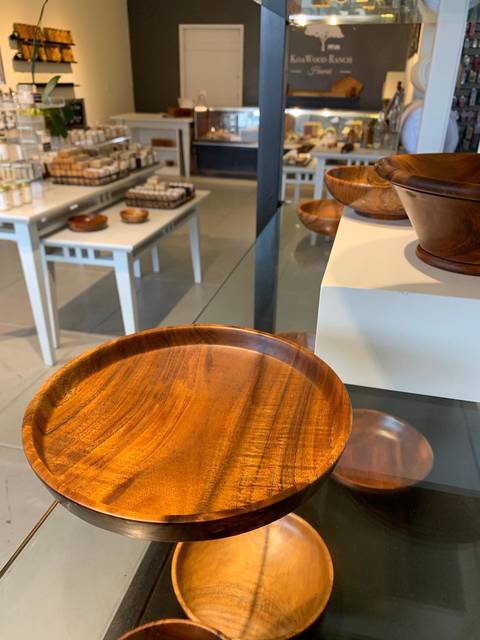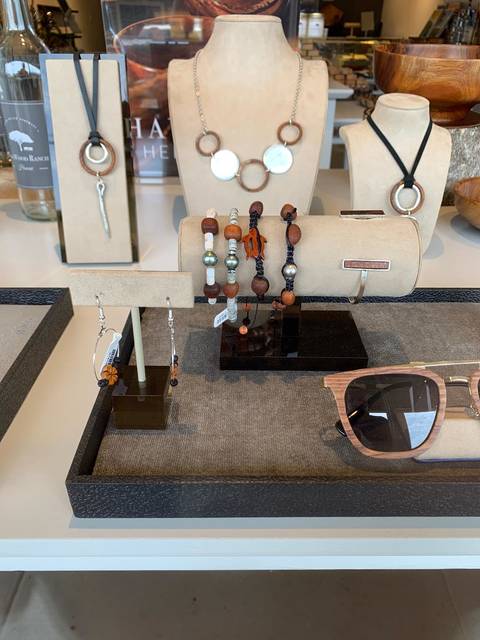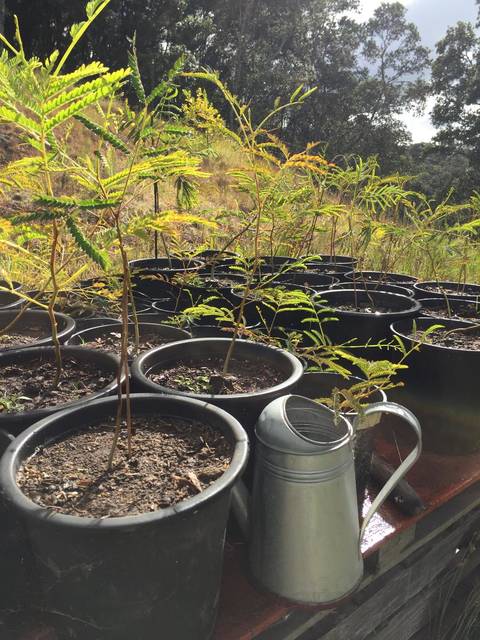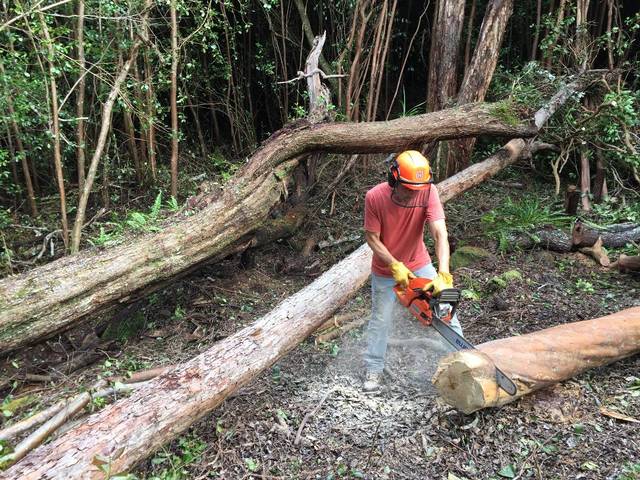KoaWood Ranch combines milling, woodworking and forest conservation all in one

A curly koa heirloom bowl handcrafted by Craig Villarrubia is one of the koa wood products from sale at the KoaWood Ranch flagship retail store in Honokaa.

Craig Villarrubia (left) and Mike Amado.

Wearable items carved from koa wood. (Courtesy photos/Craig Villarrubia)

Koa seedlings ready for planting on KoaWood Ranch.

Mike Amado, co-owner of the KoaWood Ranch cuts up an invasive guava tree on his property. (Courtesy photos/Craig Villarrubia)
PAUILLO Craig Villarrubia and Mike Amado are relative newcomers to Hawaii Island but theyre pioneers in what theyve been doing since their arrival.
PAUILLO — Craig Villarrubia and Mike Amado are relative newcomers to Hawaii Island but they’re pioneers in what they’ve been doing since their arrival.
Their KoaWood Ranch, located within the historic Kukaiau Ranch near Pauillo, is a milling operation, woodworking studio and forest conservation program all in one.
“KoaWood Ranch is a unique, fully vertically integrated koa wood business in Hawaii and the restoration and preservation of koa is at the center of it all,” Villarrubia said. “We’re devoting our skills and efforts into bringing the land back to its natural ecological heritage.”
Koa forest restoration wasn’t their original business plan. When the couple left their executive corporate jobs in Los Angeles to move to Hawaii, they had planned to follow in the footsteps of Amado’s family and become cattle ranchers.
After searching Central America, Central California and even the Caribbean, they found the perfect property — a beautiful, affordable and available 199-acre parcel 3,000 feet above sea level — on the Hamakua coast of the Big Island.
There was just one small problem. No one had managed the property for some time and it had become significantly degraded.
Not afraid of hard work, Villarrubia and Amado set out to clean up the property and in so doing discovered something they never expected.
“In most of the remote areas of the property we found old growth koa trees,” Villarrubia said. “The trees were hidden by the invasive species that had taken over.”
The discovery prompted the men to completely change their trajectory on what to do with the ranch.
“The appeal to preserve and restore the land was a natural next step,” Villarrubia said.
But first they needed to educate themselves about koa.
“Prior to moving to Hawaii six years ago I had no idea what koa was,” he said. “We learned there isn’t a lot of information about it out there. Certainly the internet is one resource, but most of what we’ve learned has come from the native people who live in the area and are from there.
“We’re fortunate to have met people who have been here for many generations.”
Amado took the lead on research and community engagement with the wood. He has learned by trial and error what works and what doesn’t with respect to planting new trees, and he works with and graduated from the University of Hawaii-Hilo/CTAHR forest stewards program. He also works with the Hawaii Department of Forestry on invasive species eradication.
He is a member of the Hawaii Forest Industry Association and communicates regularly with the USDA’s Natural Resources Conservation Service which sponsors the conservation program at KoaWood Ranch.
As the more naturally creative of the two, Villarrubia focuses his efforts on koa wood art.
“One of the first things we did when we found the old growth koa was cut open a dead tree to see what we had,” he remembered.
“I fell in love with the wood when I saw all the beautiful curls and tiger stripes.”
He had never attempted woodworking before but coincidentally, at the time koa was discovered on the ranch, his friend and nationally known artist, Carmen De La Paz, gifted him with a lathe. A wood turner herself, she was his first teacher. Villarrubia has also worked with Aaron Hammer from the Big Island and has made numerous koa bowls with wood from the ranch.
The work the men do on their property is extremely physical and exhausting. But for them it’s worth it, knowing they are preserving and restoring koa trees for generations to come.
“In some areas of the ranch where we’ve done a lot of work there are now thriving trees some of which are 20-30 feet high,” Villarrubia said.
“You look at them and say, ‘Wow, this is good. We’re having a positive effect on the environment and we all get to breathe easier because of it.’ ”
Among the challenges they face is protecting the environment when the trees are first planted.
“One of our biggest challenges is feral pigs and keeping them from destroying the keiki koa. Building fences to keep them out is a huge expense.”
Another challenge is removing invasive species. Guava, in particular, tends to block the sun from the small koa trees so the tree doesn’t get a chance to survive.
“We basically have to remove all the guava and other invasive species so the trees can get large enough to reestablish the forest,” Villarrubia said.
His efforts to propel what’s happening on the ranch into retail paid off earlier this year when the KoaWood Ranch flagship retail store opened at 45-3599 Mamane St. in Honokaa. Products sold in the store include bowls, jewelry, wallets, watches and sunglasses made mostly from koa harvested on the ranch. Proceeds benefit the conservation efforts.
“Our purpose is to bring the koa forest back so we’re not looking to take down koa trees on a commercial level. It’s important for the scale of the business to stay local and to stay small,” Villarrubia said.
“Our main objective even with the ranch is really to bring back the koa forest,” he added. “That’s our objective above and beyond everything else that we do.”


